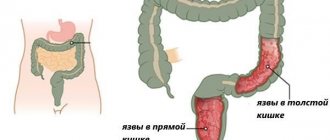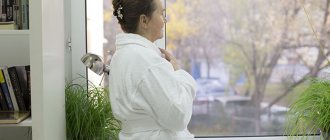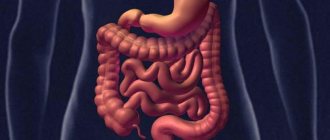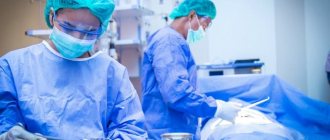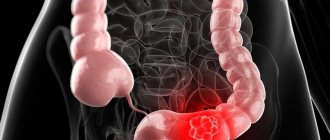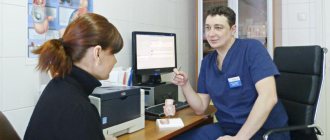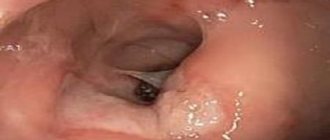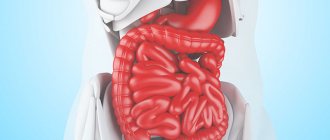Sigmoidoscopy, or rectoscopy, is a method of visual examination of the rectum and lower third of the sigmoid colon.
Our expert in this field:
Diaghilev Alexey Anatolievich
Endoscopist
Call the doctor
In oncological practice, rectoscopy is used as the most informative method, which makes it possible to detect tumors at an early stage.
The study is carried out using a sigmoidoscope - a device equipped with a video camera illuminated by a cold lamp. The image from the camera is transferred to the monitor and enlarged many times. This allows the doctor to find very small tumors that even magnetic resonance imaging (MRI) does not show.
What does rectoscopy show?
A sigmoidoscope allows you to examine the rectum and sigmoid colon to a depth of 30 - 35 cm from the anus.
Using a video camera, the doctor examines the mucous surfaces, their relief, folding, moisture, shine, color, vascular pattern, and also evaluates the peristalsis of the large intestine.
If a tumor is detected, the doctor can use a proctoscope to take a tissue sample for histological examination. This diagnostic procedure is called a biopsy.
Histological examination gives an unambiguous answer about the nature of the neoplasm - benign or malignant. In the case of colon cancer, it shows the type of malignant cells, their differentiation (degree of malignancy). This information is invaluable for choosing treatment tactics.
Rectoscopy shows any neoplasms in the rectum and lower (distal) part of the sigmoid colon - tumors, polyps, condylomas.
This method is used in the diagnosis of ulcerative colitis, paraproctitis, hemorrhoids, rectal fissures, endometriosis of the rectum (in women), prostate adenoma (in men) and a number of other diseases.
Differences between anoscopy and sigmoidoscopy
Both anoscopy and sigmoidoscopy are used to diagnose diseases of the rectum. However, the power of these studies varies. Anoscopy measures only 8-12 centimeters of the anal canal. This segment includes the anorectal region, where hemorrhoids are most often found. But damage to the rectum can also be at a higher level. In this case, the diagnostic capabilities of anoscopy to identify a pathological defect will not be enough.
If necessary, doctors conduct a more detailed examination - sigmoidoscopy. It allows you to assess the condition of the rectal mucosa over 20-25 centimeters. A deeper examination can reveal additional complications of the disease, for example, the source of bleeding from the intestines.
The study plays an important role in the diagnosis of rectal cancer, which is often located in the colorectal area. Using sigmoidoscopy, you can detect anal fissures that are located quite high. Early detection of these defects is very important, since correct and timely treatment allows you to get rid of them with the help of medications, while advanced cases require surgical intervention. The study is carried out if thrombosis of hemorrhoids is suspected, especially in the presence of internal hemorrhoids.
In general, sigmoidoscopy and anoscopy differ in the scope of diagnostic capabilities. Anoscopy is usually used as a method of primary diagnosis of hemorrhoids. Sigmoidoscopy is a more advanced procedure, so it is used to detail data and clarify the diagnosis.
Indications
Indications for rectoscopy may include suspicion of a tumor disease (benign or malignant) of the large intestine, as well as symptoms such as:
- lower abdominal pain,
- defecation disorder (alternating diarrhea and constipation),
- mucous, bloody or purulent discharge,
- presence of blood in the stool,
- a change in the color of the stool or its shape (narrow, ribbon-like), indicating the presence of an internal obstruction and narrowing of the intestinal lumen,
- difficult, painful bowel movements,
- symptoms of inflammation of the rectum.
Request a call back. We work around the clock
In what cases is it necessary to undergo examinations?
- constant pain in the anal area;
- bleeding from the anus;
- discharge of mucus from the anus;
- detection of dense formations protruding from the anus (prolapsed hemorrhoids);
- suspicion of inflammatory processes in the perianal area (paraproctitis).
Be sure to read:
More about hemorrhoids: causes, symptoms and treatment methods
In continuation of the topic, be sure to read:
- Rectal fissure: causes, symptoms and treatment of pathology
- Rectal cancer: symptoms, stages, treatment and prognosis for life
- More about hemorrhoids: causes, symptoms and treatment methods
- Diseases of the rectum: symptoms and signs of the disease, treatment
- How to check the intestines for oncology?
- Details about bowel cancer: stages, symptoms, treatment and prognosis
- Rectal prolapse: how is the pathology manifested and treated?
- Why does pain occur during bowel movements and how to diagnose the cause?
- Anal sphincter insufficiency: degrees, causes and methods of treating pathology
- Preparation and performance of sigmoidoscopy
Types of rectoscopy
- Anoscopy. To examine the anus, an anoscope is used - a video camera on a short hose 5 cm long. This procedure does not require preliminary preparation and can be performed at any time.
- Proctoscopy. To examine the rectum, a proctoscope is used - a miniature camera on a hose up to 15 cm long. Before the procedure, a cleansing enema is performed. No preliminary preparation is required.
- Sigmoidoscopy. To examine the lower part of the large intestine, a sigmoidoscope is used - a miniature camera on a flexible hose up to 30 cm long. This type of examination is most often used when colon cancer is suspected or with a confirmed diagnosis. A biopsy is performed using a sigmoidoscope—a sample of tumor tissue is taken for histological examination. The procedure requires preliminary preparation, which begins 2 days before the examination and includes a diet, refusal to eat the day before, and bowel cleansing with enemas.
Indications for anoscopy
In addition to the mandatory completion of this examination for both men and women, it is also prescribed when the following symptoms occur;
- Discharge with mucus, blood or pus;
- Hemorrhoids (single or multiple);
- Inflammation (infectious) of the intestinal mucosa;
- Constipation (chronic or long-term);
- Painful sensations in the sphincter and rectum area.
Anoscopy is also prescribed for suspected cancer, for polyps, condylomas and other neoplasms.
How is the procedure performed?
Rectoscopy is a painless procedure. It does not require anesthesia and takes no more than 10 minutes.
At the Medicine 24/7 clinic, it is performed on an outpatient basis, without hospitalization.
During the examination, the patient is in a lying position on his left side with his knees drawn to his chest. Another option is the knee-elbow position. The choice of position is determined by the indications and purpose of the study.
The doctor examines the anus with his finger. After this, carefully insert the rectoscope to a depth of 5 cm using rotating (circular) movements. Before inserting the rectoscope, it is generously lubricated with gel, which eliminates any friction and ensures free sliding.
As the proctoscope moves along it, air is supplied, which pumps up the rectum and expands its lumen.
After inserting the rectoscope to the desired depth, air pumping stops, an eyepiece is inserted through the hose, and the doctor begins a visual examination of the intestinal walls.
When recording the examination results, the doctor uses a clock dial diagram. The localization of detected tumors and other pathologies is indicated by the position of an imaginary clock hand, if we take the anococcygeal line as 6 o'clock.
After the examination, the proctoscope is carefully removed.
Differences between anoscopy and other diagnostic methods
Anoscopy is a quick and painless procedure for the patient. Unlike sigmoidoscopy and colonoscopy, it does not require serious preparation on the eve of the study, which consists of complete cleansing of the gastrointestinal tract with the help of special medications. Another difference is that during anoscopy only the anal section of the rectum is examined, while during colonoscopy the entire large intestine is examined, which can cause discomfort and pain in the patient (therefore, anesthesia is often used). Also, the study is carried out immediately at the initial appointment and does not require an additional visit to the clinic for the procedure. After the examination, the doctor immediately prescribes treatment or, if indicated, prescribes additional research methods.
In the Clinic, the procedure is performed by experienced, qualified proctologists, and, if necessary, modern effective anesthetics are used.
Contraindications
Rectoscopy is a completely safe procedure; however, there are a number of contraindications to its use:
- acute inflammation of the anal canal,
- acute inflammatory process in the abdominal cavity,
- painful fissure in the anus (anal fissure),
- insufficient patency of the rectum (with inflammation, tumors),
- purulent inflammation (purulent adnexitis, peritonitis),
- diabetes mellitus in a decompensated state,
- acute heart failure,
- severe respiratory failure,
- acute infectious disease,
- 2nd, 3rd trimesters of pregnancy.
We will call you back
Leave your phone number
Carrying out anoscopy
Includes a preliminary examination-palpation and anoscopy itself.
Preliminary examination-palpation
The examination can take place on a couch or in a special chair.
The proctologist puts on gloves and heavily moisturizes them with a special anesthetic ointment or gel.
The specialist asks the patient to push and inserts a finger into the anus. In this way, the area of the anus, coccyx, and sacrum is palpated. The patient is checked for the presence of hemorrhoids, their consistency, the condition of the walls of the rectum and the muscles of the anus. This examination helps determine whether the hemorrhoids will be able to move into the rectum on their own or not.
If the patient feels a sharp pain in the anus, then palpation should be stopped.
Anoscopy
Anoscopy is not a painful procedure, but rather not a very pleasant one, due to the delicacy of the problem and the patient's stiffness. However, anoscopy is an effective and safe diagnostic method.
Another advantage of anoscopy is that, with high information content, the examination does not require lengthy preparation of the patient. Before anoscopy, it is enough to do a cleansing enema, designed for 1.5-2 liters, with cool water after stool.
During anoscopy, an anoscope is carefully inserted into the patient's anus, this is done with soft, gentle, circular movements. Patients who have an increased sensitivity threshold are given pain relief using intramuscular injection of analgesics.
An anoscope is a smooth metal rod, devoid of any sharp protrusions, with a diameter of no more than 1 centimeter. Modern devices are equipped with lighting, which allows you to more carefully examine all the nuances of the condition of the mucous membrane.
Anoscopy can be performed for 10-15 minutes, then the anoscope is carefully removed from the patient's body.
Anoscopy is safe, has no complications and has virtually no contraindications.
The following events may be considered minor exceptions to anoscopy:
- narrowing of the lumen of the rectum and anal valve;
- acute, inflammatory processes in the anus (thrombosis of hemorrhoids, acute parapractitis). In case of acute symptoms, it is necessary to postpone the examination until the symptoms subside.
1 AKSI anoscope
2 Anoscope AKSI
3 Anoscope AKSI
Preparation for the procedure
2 - 3 days before deep rectoscopy (sigmoidoscopy), you need to give up foods that cause increased gas formation - legumes, raw fruits, cabbage and other vegetables, cereals, yeast bread, nuts, as well as eggs, sweet fermented milk products, carbonated drinks.
If the procedure is scheduled for the morning, a light lunch is allowed the day before. You will have to give up dinner. Only water or tea is allowed.
Before going to bed, a cleansing enema is done. In the morning, before the procedure, the intestines are cleansed again with an enema. In addition, a laxative may be prescribed.
If the procedure is performed in the evening, you should abstain from food during the day. Before the study, a laxative is prescribed, and the intestines are cleansed with an enema.
How does anoscopy differ from other diagnostic methods?
Examination of the rectum - endoscopy. It includes all methods of examination inside the rectum in order to detect diseases. Anoscopy is an examination of the rectum at a distance of 5–10 centimeters.
This type of research:
- studies the cause of anal fissures;
- finds hemorrhoids;
- takes a piece of tissue for testing (biopsy).
Differences between endoscopy instruments.
| Tool | Description | Preparation |
| Anoscope | Anascope is a tube from 5 to 7 centimeters. | Preparation for the analysis occurs on the day of the procedure: it is necessary to do an enema. |
| Proctoscope | The proctoscope is 10 centimeters long. Has the ability to examine a section of the rectum at a distance of up to 13 centimeters and make an injection inside the intestine, if necessary. | When preparing for proctoscopy, you should stop eating bread, fruits and legumes the day before the procedure. In the morning you can drink tea and eat a light breakfast. Also do an enema 1-2 hours before the procedure. |
| Proctoscope | The instrument has a bulb for supplying air to the rectum: it straightens the walls for a better view. There are two types of rectoscope:
| Preparation for rectoscopy is more complicated. In addition to the enema before the procedure, you must follow a special diet for 4 days. |
After the procedure
Rectoscopy at the Medicine 24/7 clinic does not cause any complications and does not require a recovery period. Residual air in the colon will continue to escape for some time - this is normal.
You should abstain from food for the first 2 hours after the examination.
Cleansing enemas and the use of laxatives can affect the intestinal microflora. Therefore, for the first days after rectoscopy, it is advisable to adhere to a dietary diet.
The material was prepared by oncologist, endoscopist at the Medicine 24/7 clinic, Alexey Anatolyevich Dyagilev.
Anoscopy, what is it?
Anoscopy is a method for diagnosing the colon. Research is carried out using a special apparatus, which is equipped with illumination. Using an anoscope, you can examine 15-20 cm of the rectum and identify pathological formations of any degree. In addition, simultaneously with anoscopy, a biopsy of the damaged area can be taken and the material can be sent for histological examination. Currently, specialists are always vigilantly monitoring cancer diseases. That is why, according to statistics, colorectal cancer has a downward trend.
In proctology, anoscopy occupies a leading place. This study is primary. Based on the results obtained, the proctologist decides on the need for further diagnostics. In many cases, an anoscopy is sufficient to begin the necessary treatment measures.
